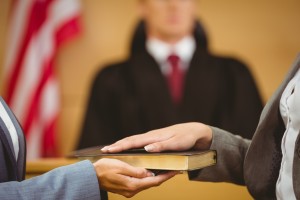The importance of good communication between an expert witness and the attorney who hires the expert is illustrated by a sanction of nearly $1 million dollars that a judge in Philadelphia imposed upon an attorney after an expert violated a court order. The controversial ruling has unsettled Philadelphia lawyers who say they should not be held accountable for mistakes made by their expert witnesses.
The Expert’s Violation of the Court’s Order
Insurance defense lawyer Nancy Raynor represented a doctor in a lawsuit alleging that the doctor’s malpractice contributed to a patient’s death. X-rays taken in response to the patient’s complaints of chest pains and shortness of breath revealed a potentially cancerous nodule on the patient’s lung. The patient was not warned about the nodule. Twenty months later, the patient was diagnosed with lung cancer. He died six months after receiving that diagnosis.
Lawyers for the patient’s family obtained an order from the trial judge barring any reference to the patient’s history of smoking. The judge agreed that the question at trial was whether the healthcare providers were negligent in failing to diagnose and disclose a potentially cancerous condition, regardless of how the cancer might have originated.
At trial, Raynor called a physician as an expert witness for the defense. During the physician’s testimony, Raynor asked whether the deceased patient “had any cardiac risk factors.” The physician answered that the patient was hypertensive and a smoker.
The jury ruled in favor of the patient’s family but returned a verdict of $190,000, an amount that barely covered the expense of the plaintiffs’ expert witnesses. The judge then granted a motion for a new trial, citing the prejudicial nature of the defense expert’s testimony and the violation of the court’s order. The judge ordered Raynor to pay $170,000 in costs incurred by the patient’s family in bringing the case to trial. The judge also ordered Raynor to pay more than $775,000 in legal fees to the two firms that represented the plaintiffs.
At a second trial, the patient’s family obtained a verdict of $1.9 million. That fact did not appease the trial judge, who rejected Raynor’s motion to reconsider his ruling. An appellate court is now considering the appropriateness of the sanction.
The Duty to Communicate with Witnesses
When the court enters an order that prohibits witnesses from giving certain testimony or mentioning specified facts, lawyers have a duty to caution their witnesses about the order. As Raynor’s case makes clear, lawyers should take pains to emphasize the importance of tailoring expert witness testimony to comply with the court’s order.
Raynor told the court that she advised the expert of the court’s order and argued that she should not be held responsible for the expert’s mistake. When questioned at the sanctions hearing, the expert testified that he “could not recall” whether he had been told not to mention the patient’s smoking habits but conceded that he “possibly” was told not to do so. Raynor called two witnesses to support her testimony that she warned all her trial witnesses about the court’s order. The judge rejected that testimony in imposing sanctions.
After a midlevel appellate court sent the case back to the trial judge for a new sanctions hearing, Raynor called a third witness who confirmed hearing her caution her witnesses not to testify about the patient’s smoking habit. The judge said that the witness’ testimony was not credible, in part because it was inconsistent with testimony given by Raynor’s other witnesses. The judge accused Raynor of deliberately violating the order to influence the outcome of the trial.
Concerns Raised About the Judge’s Ruling
Philadelphia lawyers have expressed concern about the judge’s ruling. If it is upheld on appeal, Raynor says she will be forced to close her practice and might lose her home. Lawyers worry that the case sets a precedent for imposing huge sanctions upon attorneys when their expert witnesses inadvertently violate court orders.
Dividing blame between the expert and the lawyer is at the heart of the judge’s sanction order. However that issue is ultimately resolved on appeal, the case sends a message to lawyers and to expert witnesses about the importance of communication. When a judge enters an order that limits or otherwise affects the testimony to be given by an expert, lawyers must take care to ensure that the expert is advised of the order and understands its meaning and importance.
Lawyers who want to minimize the risk that they will be held accountable for an expert’s violation of a court order might want to give the expert written notice of the order. A letter instructing the expert not to give prohibited testimony, reinforced with an oral warning immediately before the expert testifies, could save both the lawyer and the expert from the embarrassment (and financial trauma) that follows the violation of a court order.













